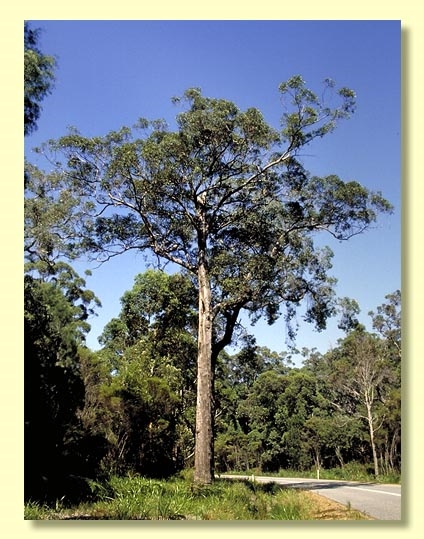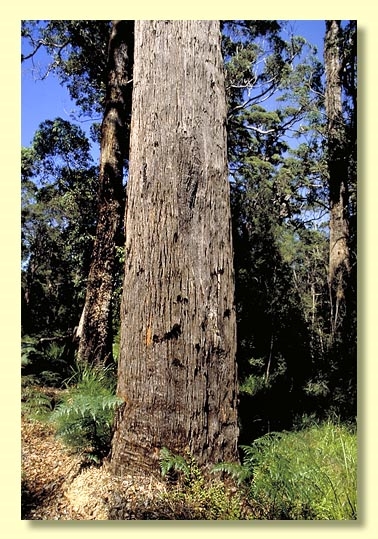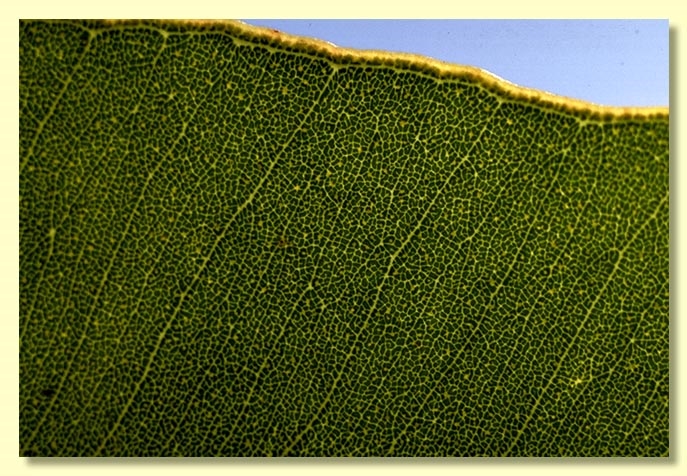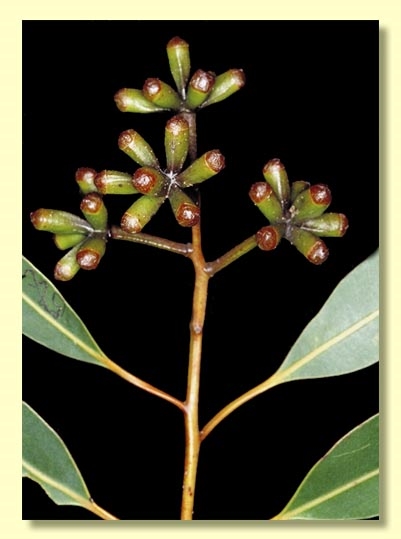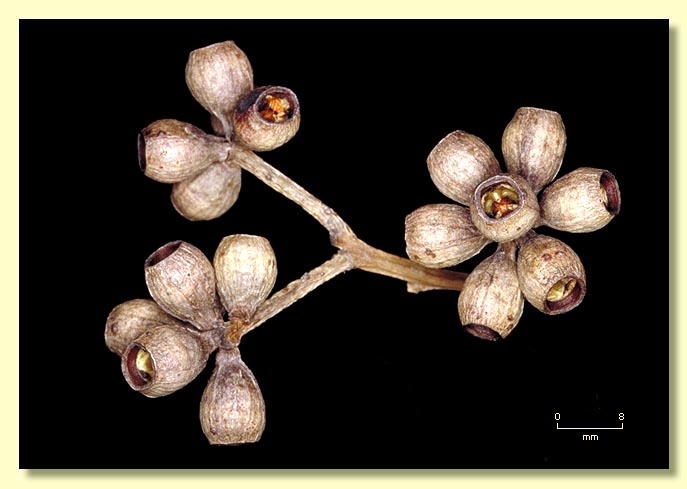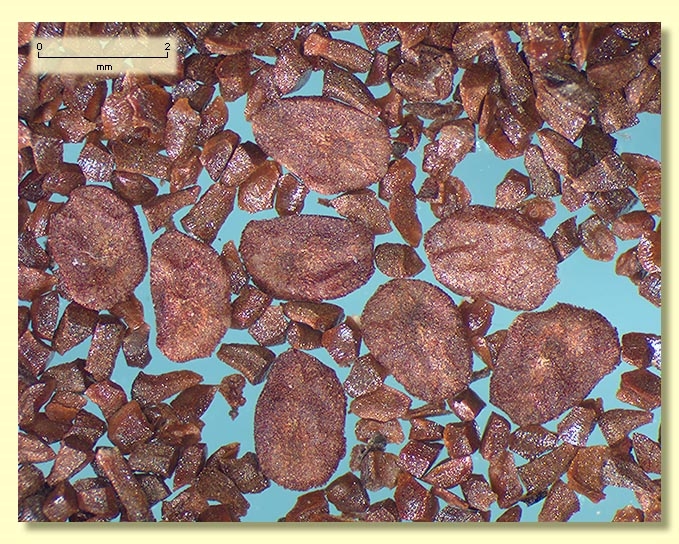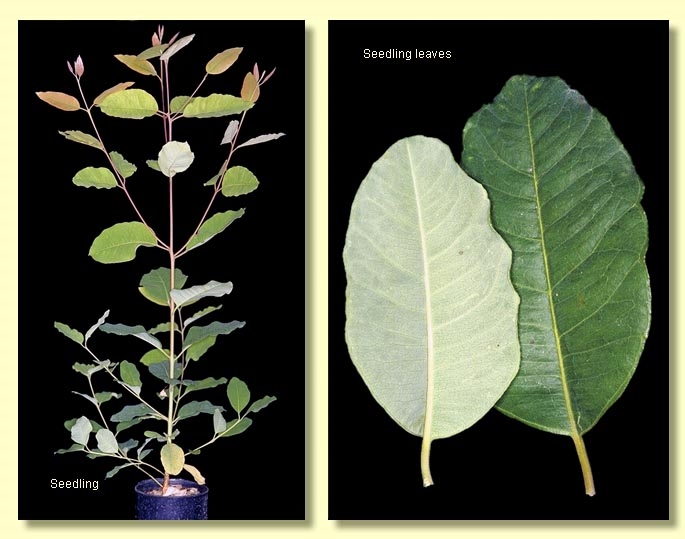Euclid - Online edition
Eucalyptus guilfoylei
Eucalyptus | Cruciformes
T: Denmark, W.A., Mar. 1905, A.Murphy s.n.; holo: NSW.
Bark rough to small branches, fibrous, fissured, grey-brown.
Branchlets lacking oil glands in the pith.
Juvenile growth (coppice or field seedlings to 50 cm): stems square in cross-section; juvenile leaves always at least shortly petiolate, opposite or sub-opposite for ca 10 nodes then alternate, ovate, 8–13 cm long, 5.5–7 cm wide, margin entire or subcrenulate, discolorous, dark green above, held horizontally.
Adult leaves alternate, petioles (0.8)1.5–3 cm long; blade broadly lanceolate to lanceolate, 8–15 cm long, 1.5–4 cm wide, base tapering to petiole, margin entire, apex pointed, discolorous, dull, dark green above, side-veins greater than 45° to midrib, reticulation dense to very dense, intramarginal vein almost confluent with margin, oil glands obscure or few.
Inflorescence terminal compound and often axillary compound also, peduncles 0.8–2.3 cm long, buds 7 per umbel, pedicels 0.1–0.4 cm long. Mature buds cylindrical or narrowly obovate, 0.7–0.8 cm long, 0.4–0.6 cm wide, slightly glaucous or non-glaucous, scar present, operculum rounded, stamens mostly inflexed with a few irregularly flexed, anthers butterfly-shaped, versatile, dorsifixed, dehiscing by oblique slits, style long and conspicuously bent at its midpoint in bud, stigma tapered, locules 3 or 4, the placentae each with (4)6 vertical rows of ovules. Flowers white.
Fruit pedicellate (pedicels 0.1–0.4 cm long), barrel-shaped, 0.7–1 cm long, 0.8–1 cm wide, disc level or descending, valves 3 or 4, near rim level.
Seeds mid-brown to yellow-brown, 2–3.5 mm long, flattened and saucer-shaped, rounded to polygonal in outline, dorsal surface shallowly reticulate, hilum ventral.
Cultivated seedlings (measured at ca node 10): cotyledons bilobed; stems square in cross-section; leaves always petiolate, opposite for 8 to 15 nodes then alternate, broadly elliptical to ovate, 5.5–10 cm long, 2.5–6 cm wide, discolorous, mid to dark green above, paler below.
Flowering has been recorded in January and December.
A medium-sized to tall tree endemic to Western Australia, of very restricted subcoastal distribution south of Perth in the vicinity of Walpole and Bow Bridge. The bark is rough and the adult leaves are discolorous, with wide-angled side-veins, densely reticulate, and apparently lacking oil glands.
The other tall, rough-barked trees that may grow in association with E. guilfoylei are E. jacksonii and E. brevistylis, both monocalypts (Eucalyptus subgenus Eucalyptus). They have discolorous adult leaves that differ from E. guilfoylei in being sparsely reticulate and glandular, and also simple axillary inflorescences, reniform anthers and more or less pyramidal seeds. E. jacksonii (Red Tingle) has red timber, while E. brevistylis (Rate's Tingle) and E. guilfoylei (Yellow Tingle) have yellow timber. The term "tingle" is thought to be of local aboriginal origin.
In the classification of Brooker (2000) Eucalyptus guilfoylei occupies a solitary position in Eucalyptus subgenus Cruciformes, having no close relatives. The inflorescences are terminal and branched, the buds have two opercula the outer of which is lost early whilst the inner operculum has four sutures. The anthers are uniquely butterfly-shaped.

